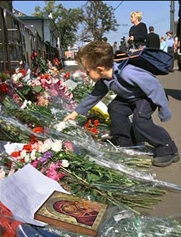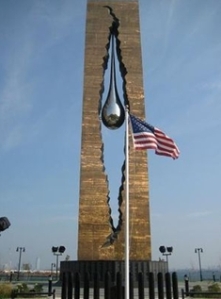 Located in the Province of Alberta, the City of Calgary is the home of 1,096,833 residents and the fifth largest metropolitan area in Canada. Also claiming 120,000 employees, it is a bustling municipality that is expected to grow substantially, with forecasts of approximately 40,000 new inhabitants and at least 60,000 additional workers by the year 2035. With so many commuters making their way to the city from the community of Sunnyside (which lies to the north of Calgary), plans for urban growth eventually turned to a means of accommodating a growing number that travel “by foot, bicycle, or in-line skates in and out of the city centre.” The result of this planning is now evident in a very unique pedestrian bridge that resolved a geographic dilemma presented by the Bow River, but which also signifies the need for world brotherhood and peace. Calgary is no stranger to the promotion of international cooperation, having hosted the XV Olympic Winter Games in February of 1988, which included the participation of fifty-seven nations and 1,423 athletes. Hence, it is probably quite natural the municipality would plan and construct a bridge that lies at the forefront of innovative architectural technique, and sports direct ties to a designer that played a major role in the aftermath and recovery from 911.
Located in the Province of Alberta, the City of Calgary is the home of 1,096,833 residents and the fifth largest metropolitan area in Canada. Also claiming 120,000 employees, it is a bustling municipality that is expected to grow substantially, with forecasts of approximately 40,000 new inhabitants and at least 60,000 additional workers by the year 2035. With so many commuters making their way to the city from the community of Sunnyside (which lies to the north of Calgary), plans for urban growth eventually turned to a means of accommodating a growing number that travel “by foot, bicycle, or in-line skates in and out of the city centre.” The result of this planning is now evident in a very unique pedestrian bridge that resolved a geographic dilemma presented by the Bow River, but which also signifies the need for world brotherhood and peace. Calgary is no stranger to the promotion of international cooperation, having hosted the XV Olympic Winter Games in February of 1988, which included the participation of fifty-seven nations and 1,423 athletes. Hence, it is probably quite natural the municipality would plan and construct a bridge that lies at the forefront of innovative architectural technique, and sports direct ties to a designer that played a major role in the aftermath and recovery from 911.
The issue of worldwide cooperation and harmony seem to be a major concern of the city, from the top down – since the mayor has been known to declare an International Day of Peace and the city has even gone so far as to sponsor events celebrating peace. The city even declared the summer of 2012 in Calgary as the “Summer of Peace.” Likewise, the University of Calgary is home to the Consortium for Peace Studies, which awards a yearly peace prize to a person who has made the world “a safer and less violent place.” Keenly aware of events in New York City that occurred on September 1, 2001, as well as the exhausting effort to rebuild the area around ground zero, Calgary chose Santiago Calatrava, the internationally known Spanish engineer and architect who designed plans for the reconstruction of the World Trade Center PATH Terminal that had been destroyed in the horrific attacks of 911. Calatrava’s projects have been known to take on spiritual dimensions like this terminal, which when finished will resemble “a bird being released from a child’s hand.” In the case of the Calgary Peace Bridge, a peace-loving city reached out to the architect that had already achieved notoriety in communicating messages with his designs.
Receiving funding from the city’s capital budget, the construction of the Peace Bridge received approval on September 8, 2008. Its structure is helical, gently arching across the river without the aid of piers submerged in the water below. Calatrava had the bridge fashioned in Spain and shipped to Calgary in parts to be assembled on the scene at a temporary structure built upstream from the intended location, but routine inspection showed that some of the welds did not meet quality standards, and the assembly process screeched to a halt while the city made arrangements with local inspectors to verify and approve the construction. Originally intended to be dedicated in the fall of 2010, delays postponed the event until March 24, 2012, much to the chagrin of the Calgary citizenry. Celebration of the grand opening included a blessing from an elder of the Blackfoot Nation, as well as “poetry, a Chinese lion dance, veterans parade and music from local entertainers.” The bridge is intended purely for pedestrians and cyclists – no motorized vehicles. Originally, authorities believed that approximately 5000 daily commuters would use it as a means of accessing the downtown area of Calgary, but the actual number since its inception has been 6000 per day.
However, the propagation of peace does not come without cost – or criticism for that matter. With building delays that hindered its completion for well over a year, many cynics have denounced the Calgary Peace Bridge for its cost, which they claim ran well over budget. The Canadian Taxpayers Federation (CTF) placed the bridge on a short list for its annual award for the most wasteful project in Canada when it comes to the use of taxpayers’ money. However, city officials countered these accusations, stating that the final cost would likely be about $30,400 per square meters, making it more economical than similar bridges that cater to the needs of pedestrians and cyclists. Other criticism has concerned the contract for Calatrava’s services, which in the opinion of some was granted without competition from other sources – in particular designers native to Calgary or Canada.
Nevertheless, there are those that have stood up to support the bridge – maintaining in the spirit of John Lennon that it’s time to “give peace a chance.” Speaking to this directive, these proponents say that it’s “time to put down our arms, stop the whining and complaining and embrace” a beautiful architectural creation that promotes peace – in a city of peace. In retrospect, they argue that the Peace Bridge is more economical than 2 other pedestrian bridges recently constructed in Fort Edmonton and Winnipeg – respectively costing $34,000 and $50,000 per metre. Officially, the Peace Bridge finally came in at $30,000 per metre. All things considered, they support Calatrava’s aesthetic masterpiece because “for its symbolic importance as a measure of where our city is heading, for its functional utility and its aesthetic quality, it was money well spent.”
It doesn’t take much to imagine the concept of a bridge as a monument devoted to the fallen victims of terrorism. An aesthetically beautiful bridge, arching across a creek in Washington D. C. – complete with a plaque of dedication – would be kind of nice actually. Don’t forget to participate in our poll below.
You can help promote the establishment of a monument dedicated to all American victims of terrorism, whether they died at home or abroad, by clicking the link above and signing the petition. Nothing is asked but your signature for a good cause.







 Stumble It!
Stumble It!